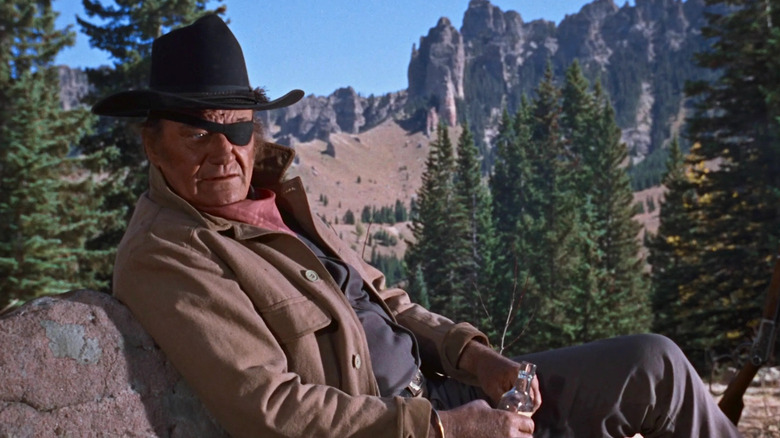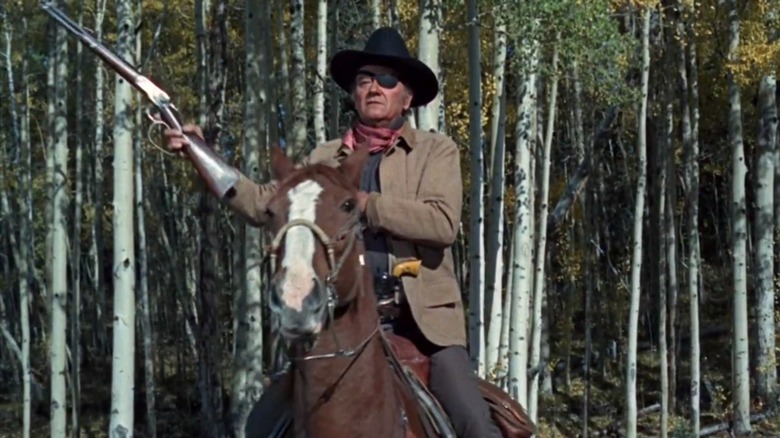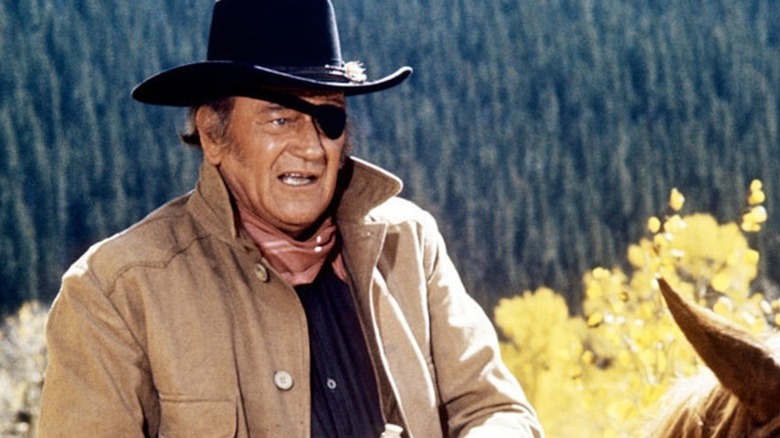John Wayne Was Far From Confident Going Into True Grit
John Wayne was in perhaps the biggest creative rut of his career in 1969. He'd just made the worst film of his career outside of "The Conqueror" in "The Green Berets," and with the advent of the New Hollywood revolution, was growing culturally irrelevant. His best collaborators, John Ford and Howard Hawks, were either fully retired or on their way out. Wayne could keep making formulaic Westerns with the hacks who let him call the shots on set, but the returns would be ever diminishing. If he wanted to matter in the film industry again, he had to take a risk.
Charles Portis' novel "True Grit," about a young girl who hires an alcoholic U.S. Marshal to hunt down the men who killed her father, offered the 62-year-old Wayne the perfect opportunity to tweak his image. The lawman role of Rooster Cogburn would allow The Duke to show off his comedic chops while still portraying him as a (surprisingly) capable hero. Upon reading Portis' book, Wayne doggedly chased the role, but once he landed it, he found himself in a dog-caught-the-car situation. He resisted some of the character's most striking flourishes. As production neared, Wayne became adamant about not donning Cogburn's eyepatch. This proved a challenge for director Henry Hathaway, who resorted to gamesmanship to get his star to buy all the way in.
The eyepatch affair
According to Scott Eyman's biography "John Wayne: The Life and Legend," Wayne was jittery due in large part to not having personally selected the screenwriter. Marguerite Roberts, a fine scenarist who'd been blacklisted for much of the 1950s, wasn't one of his guys. So he began fussing and fixated on the eyepatch.
While Hathaway was one of Wayne's guys, he lacked the authority of Ford to force Wayne to do as requested. So while The Duke was in the midst of his wardrobe fitting, he hung the eyepatch over the actor's cheval mirror. Wayne knew precisely what was up. "You're a pretty smart son of a b***h," he said to Hathaway. "No way, no way."
Wayne's resistance was partially practical. He was worried about being blind in one eye while riding a horse. Hathaway had anticipated this and assuaged his star's concerns. As he told Wayne:
"Look, Duke, if you try it on, you'll see that instead of it being a patch, I've got black gauze there. You can see through it perfectly. It's almost as if there was no patch. On top of that, for the closer shots, I have a finer gauze. Not until I take a big close-up will I use one that's completely blank. So you can see at all times."
Wayne dons the patch and wins an Oscar
If you've seen Hathaway's "True Grit" (a very good movie, but not in the same class as the Joel and Ethan Coen's 2010 adaptation), you know that Wayne relented. "He got to kind of like it," said Hathaway. It's good that he did. The eyepatch is a key visual component of the character's rough-and-tumble demeanor. The audience has to doubt Cogburn at the outset. He needs to come off as an out-to-pasture clod, an oafish drunk coasting on his reputation.
Wayne hit the mark so emphatically that he earned his first and only Academy Award for Best Actor. The film was also a box office hit, sending The Duke into the 1970s on a revitalized high. Alas, he went right back to making by-the-numbers Westerns. Though he still had a couple of good movies in him ("The Cowboys" and "The Shootist"), Wayne had peaked. There's no shame in that, but it would've been a blast to see Wayne interact with newly minted stars like Clint Eastwood, Burt Reynolds and Robert Redford.


